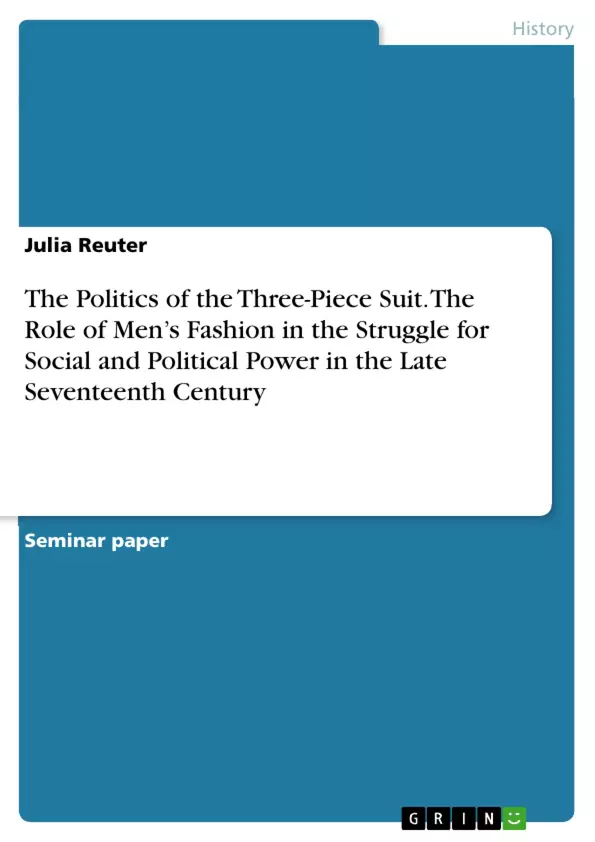What caused Charles II, a king widely known as the 'merry monarch', to propose thrift and demureness? Is there an explanation for the popularity of the new fashion? Who wore it, and from whom did they want to distinguish themselves? It is the aim of this paper to shed some light on the political and social motives for the rise of the three-piece suit. It focuses on the developments of the late seventeenth and early eighteenth centuries, beginning with 1666 and examining the post-Glorious Revolution era closely. Changes occurring in the late eighteenth and early nineteenth centuries are outlined only briefly.
A short appraisal of the historical background, specifically Charles II’s reasons for introducing the vest, can be found in chapter 2. Chapter 3 gives an overview of the development of the discourse on men’s fashion, and chapter 4 contains an analysis of the political, social and economic, as well as moral motives for promoting the three-piece suit. The paper ends with a conclusion.
Table of Contents
- Introduction
- Historical Background
- The Discourse of Thrift
- The Stuart Court versus France
- The Political Elite versus the Court
- The Upper versus the Middle and Lower Classes
- The Middle versus the Upper Class
- A Demonstration of Superiority
- Political Superiority
- Social and Economic Superiority
- Moral Superiority
- Conclusion and Outlook
Objectives and Key Themes
This paper aims to explore the political and social motivations behind the rise of the three-piece suit in England during the late seventeenth and early eighteenth centuries. It examines how the suit evolved as a symbol of elite masculinity and a means of distinguishing oneself from other social groups.
- The role of fashion in shaping political and social power dynamics
- The shift towards "inconspicuous consumption" as a symbol of elite status
- The interplay of social class, morality, and political ideology in men's clothing choices
- The influence of the French court and the development of national stereotypes
Chapter Summaries
- Introduction: This chapter introduces the concept of the three-piece suit as a new fashion trend in the Restoration era. It highlights Charles II's declaration on thrift and the evolving perception of the suit as a symbol of elite masculinity.
- Historical Background: This chapter provides context for the rise of the three-piece suit by exploring the political and social landscape of England in the seventeenth century. It focuses on the challenges faced by the Stuart monarchy, the influence of Louis XIV's court, and the emergence of anti-Puritan laws.
- The Discourse of Thrift: This chapter analyzes the development of the discourse surrounding men's fashion and the use of "inconspicuous consumption" as a means of social distinction. It examines how Charles II used fashion to control the court and establish a new sartorial regime.
- A Demonstration of Superiority: This chapter delves into the political, social, and moral motivations behind the adoption of the three-piece suit. It analyzes how the suit became a symbol of superior status and a means of distinguishing oneself from other social groups.
Keywords
The primary keywords and focus topics of this text include: three-piece suit, men's fashion, social status, political power, conspicuous consumption, inconspicuous consumption, Stuart monarchy, Charles II, Louis XIV, French fashion, English fashion, national stereotypes, elite masculinity, morality.
- Citation du texte
- Julia Reuter (Auteur), 2010, The Politics of the Three-Piece Suit. The Role of Men’s Fashion in the Struggle for Social and Political Power in the Late Seventeenth Century, Munich, GRIN Verlag, https://www.grin.com/document/1416295



